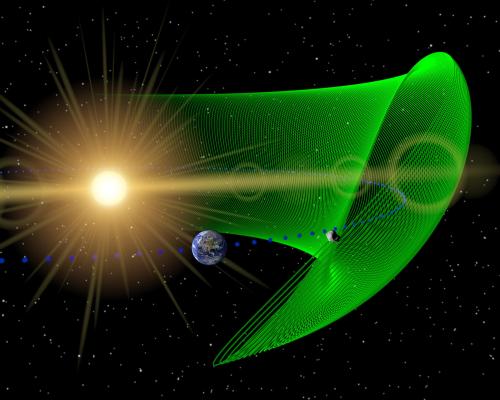NEW YORK (AP) -- Like a poodle on a leash, a tiny asteroid runs ahead of Earth on the planet's yearlong strolls around the sun, scientists report.
The discovery of this companion, which measures only about 300 meters across, makes Earth the fourth planet in the solar system that's known to share its orbit with an asteroid.

Imagine Earth and the asteroid traveling around a clock face, with the sun in the middle. Generally, the asteroid runs about two numbers ahead.
However, the asteroid sometimes ranges so far ahead that it's on the opposite side of the sun from Earth, said Martin Connors of Canada's Athabasca University in Alberta. He reports the work with colleagues in Thursday's issue of the journal Nature.
Asteroids are giant space rocks that orbit the sun, and ones that share an orbit with a planet are called Trojans. Scientists had previously found a few for Mars and Neptune and nearly 5,000 for Jupiter. Spotting one in Earth's orbit is difficult from the ground because the potential locations are generally in the daytime sky.
The newfound object, called 2010 TK7, was discovered last year by NASA's WISE satellite. Connors and colleagues were able to focus a ground-based telescope in Hawaii on it in April, determining its orbit with enough precision to show it was a Trojan.
Donald K. Yeomans, manager of NASA's Near-Earth Object Program Office, who didn't participate in the discovery, agreed that the asteroid is a Trojan. Most scientists suspected Earth had them, he said, and ``I would guess there's others.''
Online:
Nature: http://nature.com/nature
Malcolm Ritter can be followed at http://twitter.com/malcolmritter
(한글기사)
지구와 궤도 공유하는 소행성 첫 발견
지구와 같은 궤도를 돌지만 언제나 지구보다 앞서 가는 소행성 이 과학자들의 끈질긴 추적 끝에 마침내 밝견됐다고 스페이스 닷컴이 보도했다 .
캐나다 애서배스카대학 과학자들은 오래 전부터 그 존재는 예견됐지만 확인되지 않았던 지구의 트로이소행성(지구-태양과 함께 정삼각형의 꼭지점을 이루는 소행성) 2010 TK7을 발견했다고 네이처지에 발표했다.
연구진은 지름이 약 300m이며 항상 지구에 8천만㎞ 정도 앞서 가는 이 소행성에 희귀원소들이 풍부할 것으로 보이며 언젠가는 달보다 가기 쉬운 우주여행의 목적지 가 될 수 있을 것이라고 말했다.
트로이소행성군의 존재와 위치는 프랑스의 수학자 겸 천문학자 조셉 라그랑주가 1772년에 처음으로 예견했다. 이들 소행성군은 라그랑주(L.) 포인트로 불리는 정삼 각형의 꼭지점에 위치해 있다. 목성에는 이런 소행성 수십개가 앞뒤에 무리를 이루 고 있는데 1906년 독일 천문학자 막스 볼프가 처음 발견한 소행성이 아킬레스로 명 명했으며 이후 잇따라 발견된 소행성들에 트로이전쟁 용사들의 이름이 붙여져 트로이소행성군으로 불리게 됐다.
태양과 지구는 두 개의 L.포인트(트로이언 포인트로 불리기도 함)를 갖고 있는 데 하나는 지구보다 앞에 있는 L-4 포인트이고 다른 하나는 지구의 뒤에 있는 L-5 포인트이다.
태양과 다른 행성들도 L.포인트를 갖고 있으며 지금까지 목성과 해왕성, 화성에 서 트로이소행성들이 발견됐다.
과학자들은 오래 전부터 태양과 지구도 트로이소행성군을 갖고 있을 것으로 추 측해 왔지만 이들의 위치가 관측이 어려운 낮시간대 하늘에 있어 지금까지 발견되지 않다가 지난 2009년 발사된 WISE(광역 적외선 탐사) 위성 덕분에 모습을 드러냈다.
그러나 2010 TK7은 다른 트로이소행성들과 달리 안정된 궤도가 아닌 매우 특이한 궤적을 보이고 있다.
트로이소행성군은 다른 천체들의 중력 이끌림 때문에 보통 정확한 L.포인트가 아닌, 그 주변의 올챙이 모양 고리 안에서 궤도를 돌지만 2010 TK7의 올챙이형 궤도 는 매우 커서 때로는 지구 기준으로 태양의 반대편까지 이를 정도로 크다.
학자들의 계산에 따르면 2010 TK7은 앞으로 1만년 동안 지구에 2천만㎞ 이내로 접근하지 않는다. 이는 지구-달 거리의 50배가 넘는 거리이다.
연구진은 이 소행성의 행동이 다른 트로이소행성과 달리 이처럼 혼란스러운 것 은 아마도 최근에야 원래의 자리를 떠나 L.포인트에 붙잡혔기 때문인 것으로 보고 있다.
이 소행성은 지구와 성분이 같을 가능성이 크지만 크기가 작기 때문에 급속히 식어 무거운 원소가 중심부로 채 가라앉지 못했을 것으로 보이며 따라서 희귀원소를 보다 쉽게 캐낼 수 있을 것이라고 연구진은 말했다. (연합뉴스)







![[KH Explains] Hyundai's full hybrid edge to pay off amid slow transition to pure EVs](http://res.heraldm.com/phpwas/restmb_idxmake.php?idx=644&simg=/content/image/2024/04/18/20240418050645_0.jpg&u=20240419100350)






![[From the Scene] Monks, Buddhists hail return of remains of Buddhas](http://res.heraldm.com/phpwas/restmb_idxmake.php?idx=652&simg=/content/image/2024/04/19/20240419050617_0.jpg&u=20240419175937)

![[KH Explains] Hyundai's full hybrid edge to pay off amid slow transition to pure EVs](http://res.heraldm.com/phpwas/restmb_idxmake.php?idx=652&simg=/content/image/2024/04/18/20240418050645_0.jpg&u=20240419100350)

![[Today’s K-pop] Illit drops debut single remix](http://res.heraldm.com/phpwas/restmb_idxmake.php?idx=642&simg=/content/image/2024/04/19/20240419050612_0.jpg&u=)